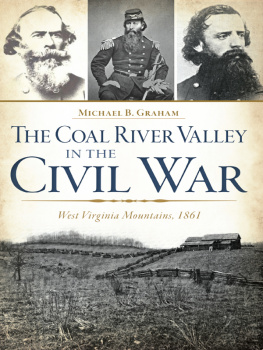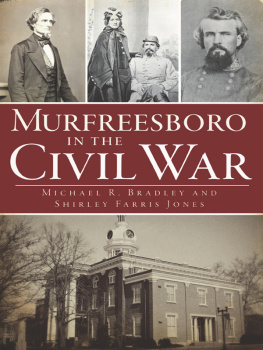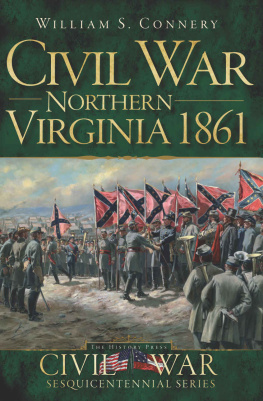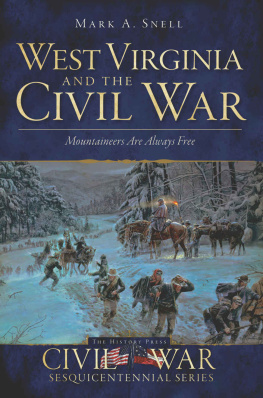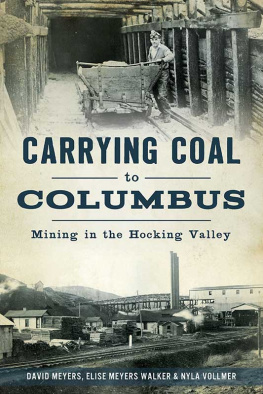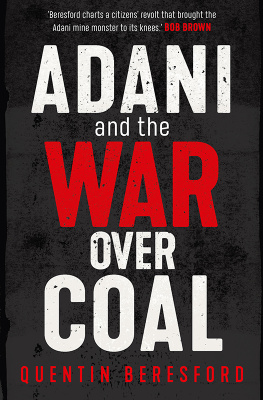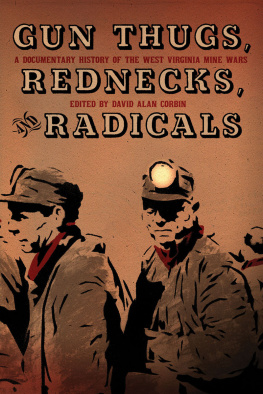

Published by The History Press
Charleston, SC 29403
www.historypress.net
Copyright 2014 by Michael B. Graham
All rights reserved
Front cover, top right: Union colonel Abraham (Abram) S. Piatt, commander, Thirty-Fourth Ohio Infantry Regiment, led the Federal force that was victorious in the Battle of Kanawha Gap on September 25, 1861. Taken from Ohio in the War (1868).
First published 2014
e-book edition 2014
ISBN 978.1.62585.192.5
Library of Congress CIP data applied for.
print edition ISBN 978.1.62619.660.5
Notice: The information in this book is true and complete to the best of our knowledge. It is offered without guarantee on the part of the author or The History Press. The author and The History Press disclaim all liability in connection with the use of this book.
All rights reserved. No part of this book may be reproduced or transmitted in any form whatsoever without prior written permission from the publisher except in the case of brief quotations embodied in critical articles and reviews.
Private Philip Roush, Company D, 141st Ohio Infantry
Private Andrew Sayre, Company H, 3rd West Virginia Cavalry
Private Thomas W. Steele, Company G, 3rd West Virginia Cavalry
Dr. George A. Vandelinde, Surgeon, 187th Regiment (Boone), Virginia State Militia
Lest we forget
CONTENTS
FOREWORD
Ive known Mike Graham since we both worked for the old U.S. Information Agency (now part of the Department of State) during the 1980s, so I was delighted when he asked me to write an introduction to his book. We both were active in an informal military history discussion group, made up of USIA employees, that met for lunch on occasion to talk about our own historical research or some pre-selected military history topic. Later, I invited Mike to speak to the Loudoun County (Virginia) Civil War Roundtable, of which I was then president, about the river campaigns early in the war in western Virginia. I know of no one who is better equipped than he to tackle the topic of this current book.
One of the joys of doing Civil War research is that, despite there being over sixty thousand books and innumerable articles already written on the subject, it is always possible to find some small niche that has yet to be explored. That is one of the values of delving into local history as well. Combine the two, and we have a perfect example of why a book like The Coal River Valley in the Civil War: West Virginia Mountains, 1861 is so useful and will always be so welcome an addition to the literature of the Civil War.
The western portion of Virginia, and the fighting that occurred therein, is one such niche study. Isolated by mountains and distant from the center of political, economic and social activity in Virginia, the region never quite seemed to fit, and movements to split it off into a separate state long predated the Civil War. It certainly is understandable that the people of Wheeling, Virginia, would have felt a much greater identification, and even kinship, with the people of Pittsburgh, only sixty miles away, than they would have felt with the people of Richmond, which was four hundred miles and several mountain ranges away. It was this isolated position and the fact that the actions occurred so early in the war that make the story of what happened in the area still fairly unknown, obscure and underappreciated.
It does not help that there were no epic battles to focus the attention of the press. Indeed, such battles as there were would more appropriately be called skirmishes, especially by later war standards. As the author points out, the total casualties over the period covered in the booknot much more than a monthbarely reaches three hundred. Nevertheless, this series of fights and troop movements contributed in a big way toward establishing Federal control over the region. That, in turn, allowed for the development of the generally unmolested political movement that eventually resulted in the creation of the state of West Virginia. A similar movement for separate statehood in eastern Tennessee failed precisely because Federal forces were unable to establish that kind of military control. Thus, today, there is a state of West Virginia but no state of East Tennessee. That demonstrates the importance of this series of small, local fights.
The Coal River Valley, and Boone County in particular, was a microcosm of Virginia and of the country as a whole. Mike effectively describes the divisions between political factions and between families, divisions that so often overlapped, thereby setting the scene for the often vicious behaviors shown by each side toward the other over and above the actual military encounters. It was often literally brother against brother, not unusual during the Civil War, but particularly noticeable on the small scale and in the local settings discussed in this book. Bloody Kansas has nothing on the western portion of Virginia in that regard.
Mike goes on to discuss, in clarifying detail, the troop movements and battles that occurred, giving them the chronological coherence that is so important, especially with actions that will not likely be well known to readers, even to most Civil War enthusiasts. The same is true of the main characters in the story, men who are important in this context but whose names generally do not appear in the larger story of the war. As someone who has himself written on a small, obscure, early war fight, I particularly appreciate Mikes ability to bring these men to life.
The Coal River Valley in the Civil War: West Virginia Mountains, 1861 is a book that needed to be written. For those with a focused interest on early war activities, it will be especially useful. For the general reader, it will provide good historical background and an increased understanding of the greater difficulties to be found in the border warfare of the period.
I am pleased to highly recommend this book to anyone with an interest in Americas defining moment.
JAMES A. MORGAN III
author of A Little Short of Boats: The Civil War Battles of Balls Bluff and Edwards Ferry, October 2122, 1861
ACKNOWLEDGEMENTS
The list of people who helped with this work is a lengthy one. Certainly, the late geologist and founder of the Boone County (West Virginia) Genealogical Society, Sigfus Sig Olafson (18971987), was an inspiration for this book. Sig Olafson, with whom I became associated as a newspaperman for the regions principal local newspaper, the Coal Valley News, was a coal and gas surveyor and friend of my grandfather Denver D. Roush, longtime town manager and the fire and police chief of Madison, West Virginia. As a surveyor, Sig came in frequent contact with the people of Boone County. He became interested in genealogy after reading the many deeds and wills that he was required to research for his surveying work. As a result, through his careful research and writings, he established himself as the expert on Boone County history and genealogy, writing many articles that appeared in the Coal Valley News, publications of the Boone County Genealogical Society and numerous national historical, geological, archaeological and genealogical works.
Another inspiration for this book was the great Civil War historian Dr. Bell Irvin Wiley (19061980), the first to examine the war from the common soldiers perspective. He found that Confederate and Federal soldiers alike relied on courage to overcome fear and felt that it was better to die facing the enemy in battle than to flee and face the humiliation and shame of their cowardly acts. In addition to providing a young undergraduate history student patient counsel and encouragement, the famous author of classic Civil War books such as
Next page
